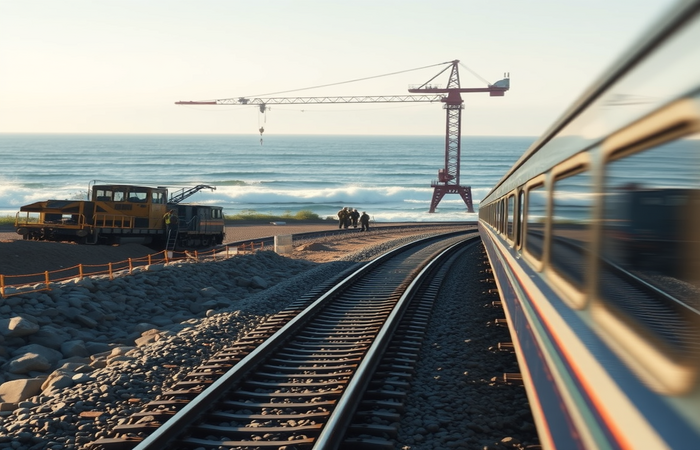MORANE-2: Teltronic’s NG CeCoCo & FRMCS

This article explores the significant role of Teltronic and its NG CeCoCo dispatching system in the MORANE-2 project, a crucial initiative aimed at modernizing European railway telecommunications. The MORANE-2 project represents a pivotal step in the evolution of the European Rail Traffic Management System (ERTMS), focusing on enhancing efficiency, sustainability, and digital connectivity across the continent’s extensive rail network. The implementation of the Future Railway Mobile Communication System (FRMCS) is central to these modernization efforts, promising significant improvements in safety, capacity, and operational efficiency. This analysis will delve into the technical aspects of Teltronic’s contribution, the broader implications of FRMCS adoption, and the collaborative nature of the MORANE-2 project in driving innovation within the European railway sector. The discussion will also highlight the importance of interoperability and standardization in achieving a seamless and efficient pan-European rail network.
NG CeCoCo Dispatching System and FRMCS Integration
Teltronic’s participation in MORANE-2 involves the deployment of its Next Generation Control Center (NG CeCoCo) dispatching system, a key component of its Mission Critical Services (MCX) suite. This system is designed to handle the complex voice communication demands of a modern railway network. Specifically, NG CeCoCo facilitates critical communications such as driver-to-controller interactions, group calls, and emergency communications. Its integration into the FRMCS framework ensures seamless interoperability with other systems across the European rail network. The successful implementation of NG CeCoCo within the MORANE-2 project is crucial for validating the practical applications of FRMCS and demonstrating its capacity to meet the demanding requirements of diverse railway operating environments.
MORANE-2 Project: A Collaborative Approach to Modernization
The MORANE-2 project, coordinated by the International Union of Railways (UIC), is a collaborative effort involving various stakeholders, including railway infrastructure managers (like ADIF in Spain) and technology providers such as Teltronic. This collaborative model is essential for ensuring the successful deployment and widespread adoption of FRMCS across Europe. The project’s focus on testing and validation, encompassing both laboratory environments and real-world railway lines (conventional and high-speed), provides a robust framework for assessing the technological readiness of FRMCS. This rigorous testing methodology aims to address potential challenges and ensure the system’s reliability and performance before its widespread rollout.
Technological Advancements and Interoperability
The MORANE-2 project’s commitment to validating the latest FRMCS specifications from the European Union Agency for Railways (ERA) underscores the importance of standardization and interoperability. This is crucial for achieving a unified and efficient European rail system. The successful implementation of FRMCS will significantly enhance the safety, capacity, and overall performance of the European rail network. The project’s emphasis on interoperability ensures that different railway systems can communicate seamlessly, promoting efficient freight and passenger transport across borders. This contributes to the overall competitiveness and sustainability goals of the European rail sector.
Modernization Goals and Future Implications
The MORANE-2 project aims to enhance the European Rail Traffic Management System (ERTMS) by increasing capacity, accelerating digitalization, and boosting competitiveness. These goals are directly linked to the wider objectives of creating a more sustainable and efficient European transportation network. The project’s success will pave the way for a more seamless and interconnected rail system, facilitating cross-border freight and passenger transport and significantly improving the overall efficiency of rail operations. This ultimately benefits both passengers and freight operators, enhancing the overall competitiveness of rail transport in Europe.
Conclusions
The MORANE-2 project, with Teltronic’s NG CeCoCo system playing a vital role, represents a significant step towards modernizing European railway telecommunications. The successful integration of Teltronic’s NG CeCoCo dispatching system within the FRMCS framework showcases the viability and practical application of this next-generation communication technology. The collaborative nature of the project, involving key stakeholders from across the European rail sector, highlights the importance of a unified approach to tackling the challenges and opportunities of modernizing railway infrastructure. The project’s focus on testing, validation, and standardization ensures a robust and reliable implementation of FRMCS across Europe. The ultimate outcome will be a safer, more efficient, and sustainable European rail network, benefiting passengers and freight operators alike. The success of MORANE-2, in its testing of FRMCS and implementation of innovative communication systems such as Teltronic’s NG CeCoCo, will serve as a crucial blueprint for future railway modernization projects globally. The emphasis on interoperability and standardization sets a precedent for seamless, efficient, and interconnected railway networks, promoting both economic growth and environmental sustainability within the European rail sector and beyond. The collaborative spirit demonstrated by the project’s participants is a testament to the potential for innovation and efficiency when diverse stakeholders work towards a shared objective. The positive outcomes of MORANE-2 are likely to influence railway modernization strategies worldwide, accelerating the adoption of advanced technologies and enhancing the overall performance and safety of railway systems globally.





